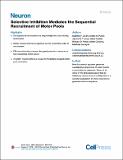Files in this item
Selective inhibition mediates the sequential recruitment of motor pools
Item metadata
| dc.contributor.author | Zwart, Maarten F. | |
| dc.contributor.author | Pulver, Stefan R. | |
| dc.contributor.author | Truman, James W. | |
| dc.contributor.author | Fushiki, Akira | |
| dc.contributor.author | Fetter, Richard D. | |
| dc.contributor.author | Cardona, Albert | |
| dc.contributor.author | Landgraf, Matthias | |
| dc.date.accessioned | 2016-08-04T11:30:07Z | |
| dc.date.available | 2016-08-04T11:30:07Z | |
| dc.date.issued | 2016-08-03 | |
| dc.identifier | 244761186 | |
| dc.identifier | ce5050a8-b902-4ca9-bfc0-d96c2c41d6fa | |
| dc.identifier | 84978881314 | |
| dc.identifier | 000382396100015 | |
| dc.identifier.citation | Zwart , M F , Pulver , S R , Truman , J W , Fushiki , A , Fetter , R D , Cardona , A & Landgraf , M 2016 , ' Selective inhibition mediates the sequential recruitment of motor pools ' , Neuron , vol. 91 , no. 3 , pp. 615-628 . https://doi.org/10.1016/j.neuron.2016.06.031 | en |
| dc.identifier.issn | 0896-6273 | |
| dc.identifier.other | ORCID: /0000-0002-5073-8631/work/52572483 | |
| dc.identifier.other | ORCID: /0000-0001-5170-7522/work/69463423 | |
| dc.identifier.uri | https://hdl.handle.net/10023/9257 | |
| dc.description | This work was supported by the Howard Hughes Medical Institute, the HHMI Janelia Visitor Program (M.F.Z. and M.L.), an Isaac Newton Trust/ISSF Wellcome Trust, and a Wellcome Trust grant (092986/Z) to M.L. | en |
| dc.description.abstract | Locomotor systems generate diverse motor patterns to produce the movements underlying behavior, requiring that motor neurons be recruited at various phases of the locomotor cycle. Reciprocal inhibition produces alternating motor patterns; however, the mechanisms that generate other phasic relationships between intrasegmental motor pools are unknown. Here, we investigate one such motor pattern in the Drosophila larva, using a multidisciplinary approach including electrophysiology and ssTEM-based circuit reconstruction. We find that two motor pools that are sequentially recruited during locomotion have identical excitable properties. In contrast, they receive input from divergent premotor circuits. We find that this motor pattern is not orchestrated by differential excitatory input but by a GABAergic interneuron acting as a delay line to the later-recruited motor pool. Our findings show how a motor pattern is generated as a function of the modular organization of locomotor networks through segregation of inhibition, a potentially general mechanism for sequential motor patterns. | |
| dc.format.extent | 14 | |
| dc.format.extent | 5298906 | |
| dc.language.iso | eng | |
| dc.relation.ispartof | Neuron | en |
| dc.subject | RC0321 Neuroscience. Biological psychiatry. Neuropsychiatry | en |
| dc.subject | QH301 Biology | en |
| dc.subject | Neuroscience(all) | en |
| dc.subject | NDAS | en |
| dc.subject | BDC | en |
| dc.subject | R2C | en |
| dc.subject.lcc | RC0321 | en |
| dc.subject.lcc | QH301 | en |
| dc.title | Selective inhibition mediates the sequential recruitment of motor pools | en |
| dc.type | Journal article | en |
| dc.contributor.institution | University of St Andrews.School of Psychology and Neuroscience | en |
| dc.contributor.institution | University of St Andrews.Institute of Behavioural and Neural Sciences | en |
| dc.identifier.doi | 10.1016/j.neuron.2016.06.031 | |
| dc.description.status | Peer reviewed | en |
This item appears in the following Collection(s)
Items in the St Andrews Research Repository are protected by copyright, with all rights reserved, unless otherwise indicated.

